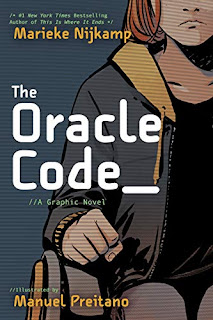DC Comics continues to hit the mark with its original graphic novels for young adults featuring familiar DC characters as younger incarnations. From Black Canary to Wonder Woman to Zatanna, and now the latest one features Barbara Gordon. No, not the Barbara Gordon who became Batgirl. This is a very different Barbara Gordon in a very different tale by writer Marieke Nijkamp and illustrator Manuel Preitano.
The Oracle Code is the story of a young Barbara Gordon, who enjoys hacking with her best friend, Benjamin. But one night changes everything. On one fateful night, Barbara is shot and left crippled, confined to a wheelchair, and suddenly everything she knows is gone - including Ben! Her father checks her into the Arkham Center for Independence (and no, this is NOT the Arkham Asylum that houses criminals - although this Center could potentially have a few criminals in there...) in order to help her with both physical and mental rehabilitation following the incident. At first, Barbara is very resistant to the place. Once inside, however, she starts to see puzzles around every corner, and before you know it, she's decided that she has to unlock whatever mysteries are hiding within the walls of Arkham.
Nijkamp tells a somewhat dark and lonely story of a Barbara Gordon who feels alone, abandoned, and out of sorts. She begins to learn, however, that being in a wheelchair is not a hindrance, but merely another obstacle to overcome. While Nijkamp brings in an entirely new cast of characters, there are subtle Easter eggs throughout the book to the Batman universe from whence she comes (such as the two basketball teams, who are the "Robins" and the "Wonders"), so that readers don't forget this is a Batman-related character, after all. And it is rather refreshing to see these children and teenagers not portrayed as individuals to be pitied because of their handicap, but as independent, strong-willed characters whose handicaps do not define them. When one of Barbara's new friends disappear, her other two friends immediately step up to the plate to help her out - - even when that means figuring out how to get a wheelchair down a set of old, stone stairs!
Preitano's art compliments the tone of the story - light when it needs to be, but dark and moody at the appropriate times. The only drawback I would say is the fact that Barbara's face through nearly the entire book has s permanent scowl - whether that was intentional or not, I don't know, but because of that, I was constantly reading her dialogue (both inner and vocal) as being pretty much spat out in an irritated tone of voice. I do, however, love the expressions on Ben when he finally comes to visit Barbara in Arkham - you can almost feel the embarrassment and shame coming off of him for having ghosted her after the shooting.
Overall, this was a great read, with a touching story that provides some great morals (i.e. loyalty, trust, determination, among other things). Quite honestly, I wouldn't mind seeing more of this Barbara Gordon. I always preferred her as Oracle than Batgirl, and this book is a shining example of why - she stands on her own and does not need a bat-symbol or any of the bat-toys to define her. Well done, DC, well done.
RATING: 10 new friends made out of cloth out of 10 for proving beyond a shadow of a doubt that Barbara Gordon can stand quite well on her own, outside of the shadow of the Bat!

No comments:
Post a Comment